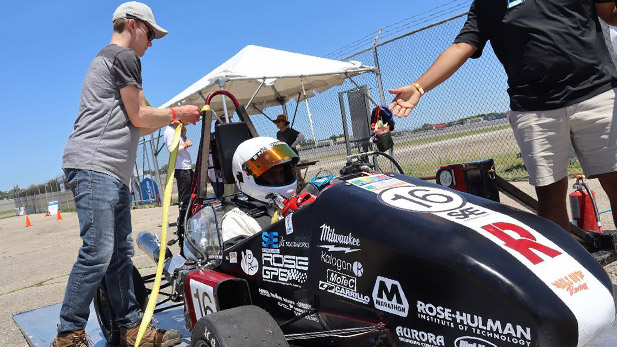Back After a Lapse, Aspiring Automotive Engineers Tweak Systems, Upgrade Parts and Compete Well

The Rose GPE team had strong top-30 place finishes while competing in on-track and technical categories in the Formula SAE collegiate design series this spring and early summer at Michigan International Speedway.
They’re back—and as competitive than ever.
The Rose GPE (Grand Prix Engineering) team comprises about 25 students in disciplines ranging from mechanical engineering to electrical engineering to computer science. Almost a dozen members were new to the team this year. They hustled all year with design, fabrication and testing, and their efforts paid off with two top-30 finishes in Society of Automotive Engineers’ collegiate design series competitions this spring and early this summer.
The team’s vehicle, built completely from scratch during the 2021-22 school year, achieved strong scores for fuel efficiency while competing autocross and endurance driving tests against more than 100 entries from across the United States, Canada and Mexico at the Michigan International Speedway in Brooklyn, Michigan. Rose GPE’s technical presentation also scored high marks from a judging panel.
“The approach this year has been an emphasis on reliability and drivability,” says team president Ben Christiansen, a senior mechanical engineering student. For example, team members revamped the electrical harness, fully implemented MoTeC engine management software, and moved from a cable throttle system to an electronic throttle control.
Using carbon-forged wheels allowed for better handling and significant weight savings, giving Rose GPE what Christiansen described as “one of the lightest cars on the grid.”
The Formula SAE competition in May at MIS was the team’s first on-track competition since 2018. (The team went to Las Vegas in 2021, but technical issues kept them from competing in dynamic events.) A competitive performance encouraged team members who could get away from summer internships and other responsibilities to return to Michigan for another round of competition in June.
Rose GPE faced challenges this year, including global material shortages and a budget cut. According to Christiansen, the team “worked tirelessly to obtain the funding and sponsorships we needed to remain competitive in FSAE.” Testing was difficult due to tumultuous weather and limited opportunity, but the team was able to make significant improvements such as redesigning the intake plenum to increase strength.
Formula SAE’s collegiate design series aims to “prepare undergraduate and graduate engineering students in a variety of disciplines for future employment in mobility-related industries by challenging them with a real world, engineering application.”
Team member Ganesh Gajavelli contributed to technology that kept the race car’s engine cool to provide maximum performance in this year’s competitions.
“I had little to no experience working with a car and had little knowledge about the Grand Prix team. I just showed up (at the Branam Innovation Center) and they put me to work,” says the 2022 mechanical engineering and computer science graduate. “Before long I was helping put pieces of the car together and watching as the cars were test driven on and around campus. It was all so exciting and kept me coming back for more.”
Gajavelli, now a software validation engineer with Tesla Inc., talks about his valuable experiences with the Formula GPE team experiences here.
Meanwhile, involvement on the team helped Nachi Hosahatti get a post-graduation job as a systems engineer with the Arrow McLaren SP race team that’s competing on the NTT IndyCar Series.
“I came into the (Grand Prix Engineering) team not knowing much and came away with a wealth of hands-on experience,” remarks the 2022 mechanical engineering graduate. “Really, this team and the [Branam Innovation Center] were instrumental in my time at Rose-Hulman. If I wasn’t in class, I was working in BIC. It was my second home.”
In fact, Hosahatti considers the BIC one of Rose-Hulman’s hidden gems.
“(The BIC) is well-equipped and everyone is welcome to use it. It is a place that you can make things, some of them fail, but you learn from those mistakes,” he says. “I owe the BIC a lot for what I learned at Rose-Hulman.”